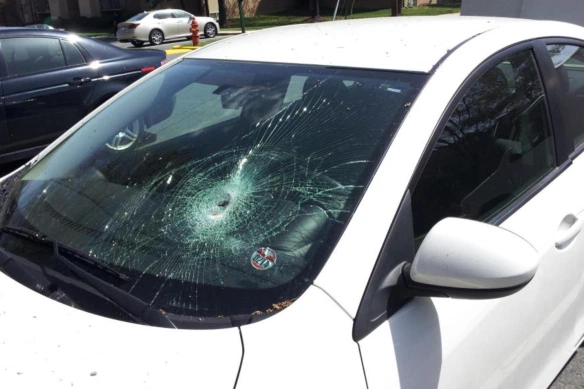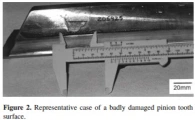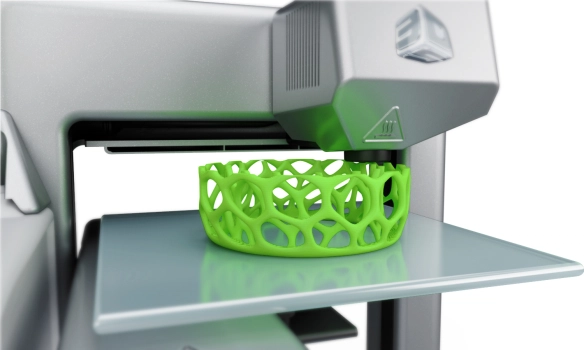 This paper, published on Engineering Failure Analysis, august 2017, présents corrosion failure analysis of an underground natural gas pipeline. The pipeline material grade is API 5L X65 with 10-in ID. The pipeline transfers multiphase fluid (gas, condensate, and water) from a gas well to a gas gathering plant, located 4200 m away from the well site. A portion of the line failed due to pitting corrosion under unknown circumstances. Based on visual and microscopic analyses and reviewing the background information, the following pitting corrosion sequences were identified: the oversized pipeline changed the dominant flow regime to “stratified”. In the stratified flow regime, the accompanying water phase accumulated in the pipelines’ low points. Considerable concentration of calcium ions along with high pH in CO2 media favored precipitation of calcium carbonate. The relatively thick scales adhered to the pipe surface were partially loosened and removed by the regional turbulent flow. This exposed the fresh steel surface to the corrosive media. The uncovered areas acted as the preferential anodic sites coupled with nearby large cathodic sites which were covered by scales and/or corrosion products. Under such conditions, pits emerged on the steel surface until one of them grew faster and failed the gas pipeline.
This paper, published on Engineering Failure Analysis, august 2017, présents corrosion failure analysis of an underground natural gas pipeline. The pipeline material grade is API 5L X65 with 10-in ID. The pipeline transfers multiphase fluid (gas, condensate, and water) from a gas well to a gas gathering plant, located 4200 m away from the well site. A portion of the line failed due to pitting corrosion under unknown circumstances. Based on visual and microscopic analyses and reviewing the background information, the following pitting corrosion sequences were identified: the oversized pipeline changed the dominant flow regime to “stratified”. In the stratified flow regime, the accompanying water phase accumulated in the pipelines’ low points. Considerable concentration of calcium ions along with high pH in CO2 media favored precipitation of calcium carbonate. The relatively thick scales adhered to the pipe surface were partially loosened and removed by the regional turbulent flow. This exposed the fresh steel surface to the corrosive media. The uncovered areas acted as the preferential anodic sites coupled with nearby large cathodic sites which were covered by scales and/or corrosion products. Under such conditions, pits emerged on the steel surface until one of them grew faster and failed the gas pipeline.
Archives pour la catégorie Publications
The Effects of Fiber Orientation and Volume Fraction of Fiber on Mechanical Properties of Additively Manufactured Composite Material
A thesis published by Conerstone : A Collection of Scholarly and Creative Works for Minnesota State University, Mankato.
Additive manufacturing (AM) also known as 3D printing has tremendous advancements in récent days with a vast number of applications in industrial, automotive, architecture, consumer projects, fashion, toys, food, art, etc. Composite materials are widely used in structures with weight as a critical factor especially in aerospace industry. Recently, additive manufacturing technology, a rapidly growing innovative technology, has gained lot of importance in making composite materials. The properties of composite materials depend upon the properties of constituent’s matrix and fiber. There is lot of research on effect of fiber orientation on mechanical properties of composite materials made using conventional manufacturing methods. It will be interesting and relevant to study the relationship between the fiber orientation and fiber volume with mechanical properties of additively manufactured composite materials. This thesis work presents experimental investigation of mechanical behavior like tensile strength and fatigue life with variation in fiber orientation and fiber volume fraction of 3D printed composite materials. The aim is to study the best combination of volume fraction of fiber and fiber orientation that has better fatigue strength for additive manufactured composite materials. Using this study, they can decide the type of orientation and volume percent for desired properties. This study also finds the range of fatigue limits of 3d printed composite materials .
Numerical analysis of impact failure of automotive laminated glass: A review
 An interesting article about failure analysis of impact on glass laminated, published on « Composites Part B »,april 2017.
An interesting article about failure analysis of impact on glass laminated, published on « Composites Part B »,april 2017.
Laminated glass is a simple sandwiched composite structure, while being widely used in the automotive industry as windshield glazings. It is considered to be safety glass due to its excellent performance in absorbing impact energy and bonding glass fragments. Meanwhile, the impact failure patterns of an automotive windshield glazing contribute to the traffic accident reconstruction. In recent decades, a growing interest has been devoted to the impact failure analysis of automotive laminated glass by means of numerical simulations. The purpose of this work is to present a comprehensive review concerning this aspect. We start by introducing six numerical algorithms for the modeling of the principal damage pattern, glass-ply cracking, followed by the introduction of material models for the plastic interlayer, PVB, and then address three numerical techniques for the adhesion modeling. Three kinds of laminated glass models are summarized. Finally, the performance of the numerical algorithms on the impact failure analysis of laminated glass in terms of glass-ply cracking and acceleration history is thoroughly discussed.
Erosion of glass fibre reinforced époxy composites
 An article published on the JOURNAL OF THE EGYPTIAN SOCIETY OF TRIBOLOGY (VOLUME 14, No. 2, April 2017).
An article published on the JOURNAL OF THE EGYPTIAN SOCIETY OF TRIBOLOGY (VOLUME 14, No. 2, April 2017).
Sand erosion of epoxy resin reinforced by randomly distributed glass fibres and filled by synthetic, paraffin and glycerine oils is studied. The effect of inclination of impact angle and oil content contained in the matrix of epoxy resin is investigated. In addition, the electrostatic charge generated on the eroded surface is measured. Reinforced epoxy demonstrates low erosion resistance compared to unreinforced epoxy. SEM surface examination reveals the effect of inclination angle on wear. Specimens filled by oil lose the electrostatic charge generated from sand erosion in earlier time compared to the unfilled test specimen.
Read more
Failure Analysis of Air Cooled Condenser Gearbox
 A new article in « Case Studies in Engineering Failure Analysis » published on Sciencedirect.com.
A new article in « Case Studies in Engineering Failure Analysis » published on Sciencedirect.com.
Gears are very reliable components and normally work 5 to 6 years without failure.
This article is a case study of failure analysis of a gearbox which was failed in three months after its installation. The problem was identified by maintenance engineers through vibration monitoring of gearbox.
La rupture en service des assemblages vissés
 Les experts en analyse de défaillances du Cetim ont réalisé courant 1988 une étude statistique de 139 cas de ruptures d’assemblages vissés. Les résultats ont montré que pour les deux tiers des cas traités, 53 % des cas de rupture est dû à un phénomène de fissuration progressive et 47 % correspond à des ruptures brutales. Pour le tiers restant, plusieurs causes conjuguées étaient à l’origine des défaillances.
Les experts en analyse de défaillances du Cetim ont réalisé courant 1988 une étude statistique de 139 cas de ruptures d’assemblages vissés. Les résultats ont montré que pour les deux tiers des cas traités, 53 % des cas de rupture est dû à un phénomène de fissuration progressive et 47 % correspond à des ruptures brutales. Pour le tiers restant, plusieurs causes conjuguées étaient à l’origine des défaillances.
Des dizaines de milliers de cas ont été traités ces quarante dernières années par le Cetim. Cette expérience fait du Centre une référence dans le domaine à même d’intervenir dans tous les secteurs d’activités. Avec aujourd’hui avec ses centres associés et partenaires, l’Institut technologique Cetim met un ensemble de compétences et de moyens au service des industriels et experts pour analyser, comprendre et proposer des solutions permettant d’éviter la reproduction de ces défaillances..
Surface Contact Fatigue Failure of a Case Hardened Pinion Shaft
 An article published in « Materials Research« , april 2014.
An article published in « Materials Research« , april 2014.
An investigation was made to determine the causes of surface contact fatigue failure of a case hardened driver pinion located in the intermediate shaft of a reducer gearbox used in a sugar and alcohol mill. The examination of the component revealed the presence of a cemented layer substantially thicker than that generally specified for pinions devised for this application.
Cas concrets – Les défaillances touchent tous les domaines d’activité
Six fiches d’analyse de défaillance publiées en 1975 dans Cetim-information sont mises à votre disposition dans la Mecatech.
Des dizaines de milliers de cas de défaillances ont été traités ces quarante dernières années par le Cetim. Les quelques 110 fiches de cette série « Cas concrets » sont issues d’articles publiés dans la revue Cetim-Informations dans les années 1974 à 1990. Bien que ces fiches traitant de cas concrets soient anciennes, leur contenu est toujours d’actualité…
Cette expérience fait du Centre une référence dans le domaine, à même d’intervenir dans tous les secteurs d’activités. Avec aujourd’hui ses centres associés et partenaires, l’Institut technologique Cetim met un ensemble de compétences et de moyens au service des industriels et experts pour analyser, comprendre et proposer des solutions permettant d’éviter la reproduction de ces défaillances.
Corrosion atmosphérique. Protection anticorrosion des équipements
 Un ouvrage publié par le Cetim qui fait le point sur le sujet.
Un ouvrage publié par le Cetim qui fait le point sur le sujet.
La corrosion est définie comme l’intéraction physico-chimique entre un métal et son milieu environnant. Elle entraîne la dégradation des propriétés fonctionnelles de l’équipement. Cette interaction est généralement de nature électrochimique.Les mesures de la corrosivité d’une atmosphère sont réalisées soit par mesure des polluants, soit par mesure de la vitesse de corrosion par exposition sur site de coupons de corrosion.Cet ouvrage fait le point sur les quatre classifications des corrosivités d’atmosphères répertoriées dans des normes de protection anticorrosion, ainsi que leurs formes qui varient selon le support métallique sur lesquelles elles s’appliquent : aciers, aciers inoxydables, alliages, aluminium, tôles, cuivres, etc.
Plus d’info : cliquez ici
Failures of cranes due to wind induced vibrations
An interesting paper in « Engineering Failure Analysis »published on ScienceDirect.com.
Two different crane types suffered severe wind induced vibrations of tension bars for the counter weights during standstill periods. The vibrations led to fatigue fractures of tensions bars followed by collapses of the cranes. The parameters of wind speed and angle for the tension bar profiles were identified conducting comparative wind tunnel experiments. Recommendations for identification and prevention of wind induced galloping vibrations of tension bars were developed.




